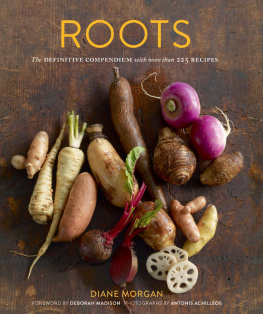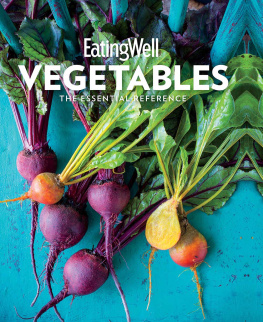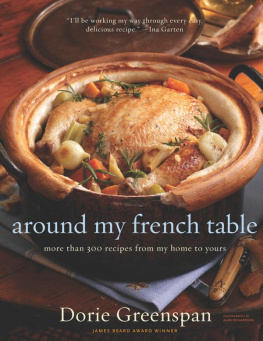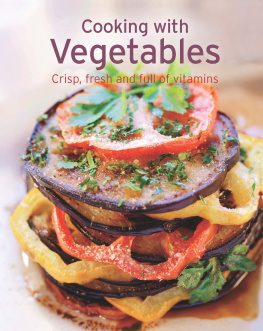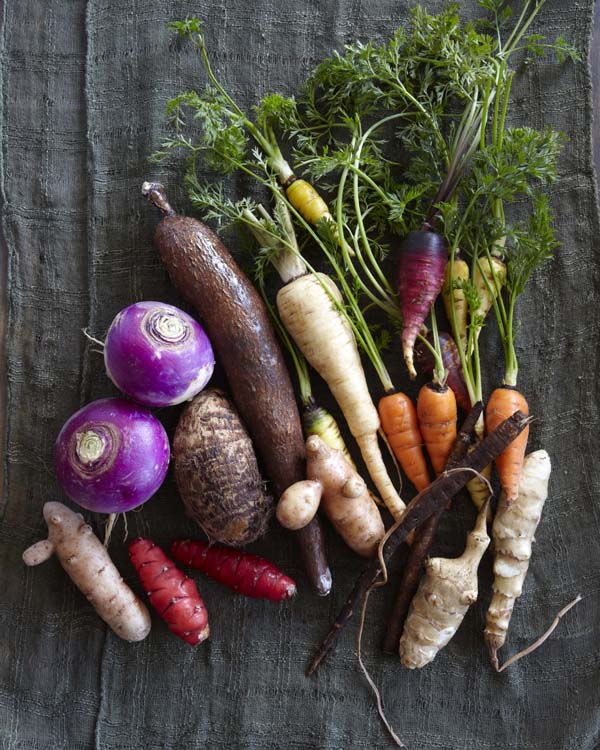GOOD ROOTS ALL THE WAY DOWN
by Deborah Madison
Diane Morgan has written a masterful book about root vegetables, and Im honored to have been asked to write this foreword for Roots, her truly worthy volume. The challenge of doing so got me to thinking about roots, not just the ones we cook, which are so thoroughly covered in this book, but roots in a more human, less vegetable realm and the vital role they play in both our culinary and our psychological worlds. Curiously, they overlap in some ways.
Its difficult to imagine the human world without the idea of roots. What are our roots? To whom and to where do we return for our most rooted essence? Do our roots run deep in a culture, history, or spot on this earth, or are we mere transplants, people who embrace a new place of residence and its culture but who arent from that locale? The sense of the transplant is keenly felt in the warm regions that attract those from the cold climate. New Mexico has its strong native cultures that you might feel youve disrupted by adding your presence. Youre not recognized as being from Vermont if your family hasnt lived there for many generations. Those who have deep roots in a place are respected and proud of them, whether they can trace their people back to the Mayflower or can claim to be a seventh-generation Californian, New Mexican, New Yorkerit matters not the place, only the time spent there, preferably measured in generations. We humans have an abiding interest in family trees, and trees, of course, have roots as well as trunks and branches. Sometimes in life we decide to go back to our roots as a way of reestablishing ourselves in attitude or approach to the world. When my Southern husband tasted pork after being a vegetarian for twelve years, he definitely went back to his roots. Culinarily speaking, he was home. He wasnt a Southerner for nothing.
A literary woman I once worked for had an odd but clearly scathing phrase that she used to describe an acquaintance of hers. She would say, She is very nice, but she has no roots all the way down. All the way down. She must have had the idea of a taproot somewhere in her mind, a single, strong root that goes down deep to find its nourishment or, in this case, its character. It was a peculiar thing to say, but somehow I knew exactly what she meant. A rootless person is lacking in substance, is not firmly attached or committed, be it to a place, a person, or an idea. Those who are rootless might skittle across the surface of their lives like a tumbleweed whose shallow roots have lost their grip on the earth come winter. Once you start to think about the importance of roots, you see them mentioned in all kinds of places, including advertisements. We know our roots, brags the founder of Bobs Red Mill, speaking of grains and where they come from.
Indeed, a special regard is given to the roots of plants that is not always given to stems and leaves. Plants are extolled for their root systems, and the deeper, larger, more complex they are, the more likely they are to impress. Take the tall prairie grasses of the Great Plains. Wes Jackson, founder of The Land Institute, often brings the root system of a single plant with him when he gives his talks on the perennial crops he is developing in Kansas. The roots of this grass go over his considerably high shoulder, cascade down his back, and trail along the floor, the whole thing resembling an intricately woven mantle. Its easy to see how roots such as these would knit the soil of the prairieinto a rich and stable home. The prairies didnt blow away until those long grass roots were destroyed to make room for the more shallow-rooted wheat.
The roots of other plants are small and delicate. They spread out and hover near the surface where their chances of capturing nourishment are best. Pine trees in the Adirondacks may grow tall, but their shallow roots leave them vulnerable to high winds and storms. When you see them fallen, you can scarcely believe those roots were able to support such a tall tree for as long as they did. In contrast, the roots of other plants, notably those in dry places, go deep indeed, plunging 50 feet/15 meters into the earth. These are strong, well-rooted beings that intend to stay put for a while. Its hard work to dig up the deep-rooted junipers and salt cedars that dot the Colorado Plateau, but when one succeeds, water suddenly becomes available to other plants, which begin to flourish.
Roots, with the exception of aerial roots, are the plants organs that grow beneath the soils surface. They are what survive once the ground has closed up for winter and the leafy matter and stems have frozen and died. Roots dont bear leaves or fruits. They dont have nodes. They arent stems, although swollen stems are often treated as roots. Taproots may be tapered, round, flat, lumpy, smooth, dull, or brightly colored. Regardless of their looks, their work is to absorb and store water and nutrients, all the while holding the plant fast to the ground so that it doesnt blow away, which in turn prevents the erosion of the soil in which it lives and that nourishes itin other words, its home.
The underground world of edible roots, tubers, corms, and rhizomes is vast and extremely useful both in and out of the kitchen. Many herbal medicines and teas are derived from the roots of plants. Im thinking of angelica, sassafras, licorice, sarsaparilla, ginger, osha, turmeric, and ginseng, for starters. Sugar is pulled from sugar beets; the diosgenin in wild yams is converted to estrogen. Eyes water and the nose stings when (happily) confronted with horseradish and wasabi. In the kitchen, roots find their way into every course of the meal, from pickles to soups, salads to entres, and breakfast, from hash browns to parsnip muffins. They even show up in desserts, lending their good sweetness to carrot cake, beet-enhanced chocolate cake, and ginger ice cream.
Roots are a storehouse of nutrients that feed life itself. Even if you do nothing, sprouts leap forth from potatoes whether theyve been stashed in a dark drawer or suspended in water. Sweet potatoes left on the counter eventually put forth their purple sprouts. Beets held in a jar of water with toothpicks will produce a virtual garden of green leaves in winter. Turnips, too, will eventually start to sprout leaves. What a goldmine of energy all of these edibles harbor. One cant help but think its a good thing if some of that energy is transferred to our bodies, and indeed, edible roots carry many benefits: vitamins, minerals, antioxidants, plenty of fiber, and few calories.
And yet, so many people think of roots as dull and brown and stodgy. Theyre not, of course. If you dont already know this, youll find out in reading Roots that color abounds, from scarlet radishes to golden, striped, and burgundy beets. We have pale gold rutabagas and snowy whitefleshed turnips; orange, purple, and yellow carrots; and red-skinned and orange- and even lavender-fleshed sweet potatoes. Roots can be brilliant and they can brighten the dark skies of winter at the table with ease.
Given the importance of roots for ones sense of self in the world and for the physical well-being and pleasure that esculent roots provide, roots deserve special attention in the kitchen, which they have been given in heaps in Dianes work. Impressive in its scope, she definitely gives roots their due and then some. Not content to rest with the familiar roots of the supermarket, her broader scope includes roots of the Andes (ullucos and yellow potatoes), rhizomes (ginger and turmeric), and an odd collection of tuberous roots (kudzu and prairie turnips), of which the sweet potato is the most familiar. Corms, those swollen underground or underwater plant stems, include taro and water chestnuts, as well as arrowhead, konjac, and malangastrangers to many, no doubt. They were to me until I opened this book. But many of the plants we now eat were also strangers not that long ago. I can remember when jicama was something of a novelty. Yuca is still new to many, as are Chioggia and golden beets and deep purple-skinned carrots, even though the earliest carrots were likely purple. Some roots were once familiar but no longer are, and Im glad to see that Diane has thought to rescue them. Salsify, scorzonera, Hamburg parsley, and turnip-rooted chervil have come and gone from our tables before. In

